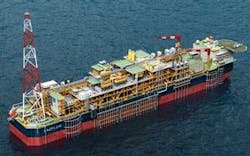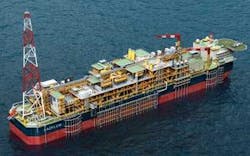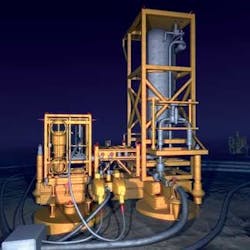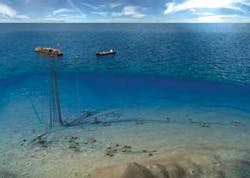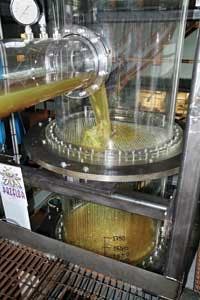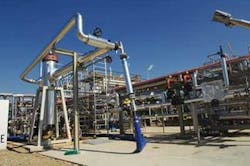Total turns to subsea separation for problematic Pazflor crude
Jeremy Beckman, Editor, Europe
Total has launched its third stand-alone development in Angolan deepwater block 17. Pazflor will combine production from one Oligocene and three Upper Miocene fields on the block’s edge, spanning a total area of 600 sq km (232 sq mi).
Like its forerunners Girassol and Dalia, this project extends the boundaries of subsea technology. Its foremost innovation, and main element of risk, is its seabed gas/liquid separation system, the first in the world to be applied from field start-up.
Pazflor, around 150 km (93 mi) offshore Angola, comprises the elongated Miocene structures Hortensia, Perpetua, and Zinia, and the compact Oligocene anticline, Acacia, nestling just to the south of Hortensia. All were discovered during 2000-03, with Acacia and Perpetua undergoing further appraisal during 2004-07. Water depths vary from 600 m (1,968 ft) on Zinia in the east to 1,200 m (3,937 ft) on Acacia.
In size, the four fields combined are much larger than Dalia or Girassol with its subsea satellites Jasmim and Rosa. The recoverable oil, however, is somewhat smaller – “600 MMbbl or a bit more,” according to block 17 director Denis Lemarchal. Acacia, which holds one-third of these reserves, always has been part of the equation, despite the project’s former title “Miocene Pole.”
Total started preliminary technical studies in-house in 2002, including petrophysics and fluid analysis in Pau, southwest France, before progressing to conceptual engineering, based on the block 17 model of a large FPSO linked to a network of subsea wells. From the outset, the main issues were how to extract the viscous, sour, heavy Miocene crude and associated gas – a combination liable to cause foaming and calcium naphthenate formation – and how to do this, given a reservoir pressure of only 200 bar (20 MPa).
Various contractors participated in screening studies in 2005, focusing on three concepts short-listed by Total for artificial lifting for the Miocene fields. These involved:
- Subsea multi-phase pumping
- Multi-phase pumps with gas lift
- Subsea gas/liquid separation.
The first option was soon discounted, as this called for high ΔP and power across the subsea multi-phase pumps – not a technically feasible solution. Framo and Aker Kvaerner Subsea provided technical definition studies for the second option. Here, the main perceived constraints were complexity, cost, and the limited length of the Miocene oil column suitable for gas injection.
Doris Engineering had worked with Total from an early stage on the more ambitious third scenario, (with Aker Kvaerner Subsea, FMC Technologies, and Vetco Gray participating in parallel subsea separation studies during the conceptual phase). Total concluded that this concept offered numerous advantages, including the use of single flowlines in place of the production loops applied previously on Girassol and Dalia.
“Total then consulted SPS Contractors to develop a technical solution for Pazflor based on subsea gas/liquid separation,” Lemarchal explains. “All technical aspects were investigated, including technical maturity and risk assessments – clearly of prime importance, as the Miocene oil production would rely on the availability of the subsea separation units.
“The results of these different studies looked more and more convincing, so that eventually subsea separation was retained as the front-runner scenario, despite its associated risks. Following a cost estimation exercise, the recommendation for basic engineering went successfully through Total’s internal validation process, also securing approval from the block 17 partners StatoilHydro, ExxonMobil, and BP. Sonangol was kept informed of this decision-making process, via regular technical meetings.”
Qualification tests
The equipment qualification program, which started in 2006, had focused on separation and pumping, both tested on prototypes.
For the separation test, Total adopted a phased approach, involving:
Step 1: Tests with viscous synthetic oil in transparent downscaled units under atmospheric pressure at Cranfield University in England. The twin aims were to determine the optimum separator configuration (horizontal or vertical), and to assess different internal arrangements. The conclusion was that although separation performance was similar, the vertical configuration was less prone to build-up of sand deposits.
Step 2: Tests with real Miocene crude (oil from Dalia, with some Sincor added to increase the viscosity) and gas. This program was conducted over four months last year at IFP’s research complex in Solaize, near Lyon. IFP and Total devised a purpose-built closed-loop, gas/oil/water separation facility, employing actual size vertical and horizontal (three-phase) separators, both operating at 23 bar (2.3 MPa) over a 40-80º C (104-176º F) temperature range.
The trials in Solaize confirmed the optimum gas volume fraction (GVF) figures for the design of Pazflor’s subsea pumps. Additionally, both the Cranfield and Solaize campaigns investigated high viscosities (2,500-3,000 cP) to simulate the behavior of Pazflor crude during a cold re-start at 4º C, as well as various flow rates, operating pressures, and inlet piping arrangements.
Towards the beginning of 2009, Total aims to start a final phase of tests in Solaize using actual Pazflor Miocene crude. These will serve to validate the subsea separation concept, two years prior to installation of the equipment in block 17. “For liquid pumping, our initial thoughts were to use centrifugal pumps,” says Lemarchal. “However, first results of the separation performance tests indicated gas carry-under in the liquid of up to 15%, necessitating the use of a more gas-tolerant pump.
“Hybrid pumps including gas-tolerant first stages were proposed by two pump suppliers, Framo and Aker Kvaerner. Prototypes were then built and tested against Pazflor’s requirements. Finally, the Framo hybrid pump was selected in all the tenders for the subsea separation units.”
Flow arrangement
Last December, the partners approved Total’s $8.5-billion development plan for Pazflor, targeting first oil in 2011. This is based around an FPSO processing oil from 25 subsea production wells, with 22 water injectors and two gas injectors.
The FPSO will have capacity to process up to 220,000 b/d of oil, and storage for up to 1.9 MMbbl, lifting block 17’s overall production capacity to over 700,000 b/d. The topsides also will be equipped to handle both the 17-22 º API Miocene crude and the 35-38 º API Oligocene input. As with Girassol and Dalia, the oil will be exported to shuttle tankers via an offloading buoy.
The wellstream from the Miocene fields will exit through three multi-phase production flowlines, each connected to the vertical separator within the three subsea separation units (SSUs). Production trees will be “teed” individually or in pairs on each of these lines instead of being manifolded; this allows the well trajectories to be shortened, thereby reducing drilling costs. Following separation, the passage of the liquids will be boosted via 2.3 MW hybrid pumps, designed and manufactured by Framo, each with a design capacity of 70,000 b/d.
Total awarded FMC Technologies a $980-million contract covering the 49 subsea christmas trees, the three SSUs, a subsea control system, three Oligocene production manifolds, flowline connection systems, and umbilical distribution units.
Each SSU will have dimensions of 15 x 15 x 25 m (49 x 49 x 82 ft), with a weight in water per unit of around 700 metric tons (771 tons) including the foundations. They will be configured to separate oil at 110,000 b/d and gas at 1 MMcm/d (35 MMcf/d). FMC subsidiary CDS is responsible for designing and testing of the subsea separator internals; externally, the separators will be manufactured from inconel cladded steel.
All the SSUs will be located close to Pazflor’s first production well to ensure quick heat-up during a cold re-start. There will be one common umbilical for each production line connected to the production wells via flying leads, while the injection wells will be controlled by dedicated injection umbilicals. Each SSU will also have its own power and control umbilical.
According to Lemarchal, “The SSUs will each be fitted with two pumping modules to guarantee maximum availability and the required redundancy. It is also important to safeguard the versatility of the artificial lifting system relative to production conditions during the field’s lifespan, in particular, the changing oil/gas ratios. For this reason, we could also use multi-phase (for high GVF) pumps or centrifugal (for low GVF) pumps, as the system allows for easy deployment.”
The 49 horizontal production and injection christmas trees will be fitted with vertical connectors, a first for block 17. In addition, the 25 production trees will be equipped with multi-phase flow meters for production allocation purposes, and in place of a surface test separator.
The subsea separation solution also will benefit the topsides layout on the FPSO, Lemarchal points out. With no gas lift, the gas compression equipment can be downsized compared with Girassol and Dalia, and there is no need for topside pumps or heaters for dead crude circulation during shutdown.
Also, with most of Pazflor’s gas reaching the processing system via separate risers, the size of the first-stage separator can be reduced, with no need for a slugcatcher. “The separator is required solely to handle the Oligocene effluent, with two processing trains in parallel treating a mixture of Miocene and Oligocene crude – nothing very complex. Furthermore, the overall efficiency of the artificial lifting procedure leads to reduced power generation requirements, compared with bottom riser gas lift.”
Acacia’s Oligocene oil will be developed with ‘conventional’ 16-in. (40.6-cm) pipe-in-pipe flowline loops, connected to three four-slot manifolds – similar to the arrangements on Girassol and Dalia.
“The preservation strategy here is based on live oil displacement with stabilized oil,” says Lemarchal. “Acacia’s reservoir pressure will be maintained by combined water and gas injection; water in most of the Oligocene horizons, with gas in the Oligocene upper sands. Again there will be one common umbilical serving the production wells, with the injection wells being controlled by dedicated injection umbilicals.”
As with Dalia, Acacia’s fluids will travel to the FPSO through two integrated production bundle (IPB) risers. These will incorporate production lines and gas-lift tubes, but with a slightly smaller overall diameter of 10 in. (25 cm) as opposed to 12 in. (30.5 cm) for Dalia. Unlike Dalia, no electrical heating cables to limit cooling of fluids during a shut-down.
Pazflor has modest quantities of associated gas, which initially will be partly re-injected into the Pazflor reservoirs, and partly employed on the FPSO facilities. In normal operating conditions, gas flaring will be avoided, initially through re-injection, later on by exporting the gas through the proposed Angola LNG liquefaction plant, due to enter service in early 2012.
Drilling schedule
Daewoo Shipbuilding and Marine Engineering (DSME) will build the 325-m (1,066-ft) long, 32-m (105-ft) wide, 61-m (200-ft) high FPSO in South Korea, with KBR in Houston subcontracted for engineering, procurement, and interface design services for the 32,000 metric ton (35,274 ton) topsides. “This is the first time DSME has worked for us as a main contractor,” says Lemarchal. “It also provided the FPSO for Dalia, but there Technip was the project leader.”
Measures to limit the FPSO’s environmental impact will include eliminating flaring under normal operating conditions, and, as on Dalia, recovering vent gases via a compressor to be supplied by Dresser-Rand. One innovation will be the adaptation of the turbines to recover heat from the exhaust gases.
Development drilling should start in spring 2009, initially using thePride Africa. From mid-2010, the newbuild dynamically positioned drillship Saipem 12000 will arrive to accelerate the program. “We should start production with 23 wells,” says Lemarchal, “and thereafter, ramp-up should be quite fast to the plateau rate of 200,000 b/d.
“The development plan is based on 49 wells, but obviously during the life of the field there may be a need for one or two more or a few less, depending on performance.”
That base case may also change following the results of two planned exploration wells later this year on untested Miocene and Oligocene structures close to the Pazflor fields.
As for the well architecture, “Total did some work in-house on the Pazflor completions to address issues such as sand control and gas management,” Lemarchal says. “Some of the wells will be more complex, i.e. dual-drain multi-laterals.”
Technip and Acergy were jointly awarded the $1.86 billion subsea umbilical riser and flowline contract. Offshore installations will start in 2010, using Technip’sDeep Blue and Deep Pioneer construction vessels, and the AcergyPolaris and Polar Queen.
Technip’s responsibilities cover engineering, procurement, fabrication, and installation of over 80 km (49.7 mi) of rigid steel production and water injection flowlines; flexible risers; and IPB risers. The flowlines and subsea structures will be assembled in Angola at the company’s Dande spoolbase. Technip will also engineer and supply over 60 km (37 mi) of umbilicals, to be manufactured by the Angoflex joint venture in Lobito.
Acergy’s scope includes engineering, fabrication and installation of 55 km (34 mi) of water injection, gas injection, and export lines, umbilicals, and over 20 rigid jumpers. All manufacturing will be handled by the Sonamet yard in Lobito, which the company owns jointly with Sonangol. Additionally, Acergy will install the subsea manifolds, the SSUs and associated umbilicals, and the FPSO’s 16 mooring lines. Detailed design for the mooring system has yet to be awarded.
To reinforce local content – increasingly an imperative for West African projects – around nine Angolan yards, including those listed above, will manufacture numerous other items under subcontract. These will include the suction piles, boat landings, riser and mooring protection structures, helideck, and various topsides pipe racks, foundation piles, support frames, and other structures for the three Oligocene manifolds, the christmas trees, and the SSUs.
“Total has acquired a strong knowledge from its previous block 17 projects,” says Lemarchal. “This started with Girassol, the world’s first giant subsea development in 1,300 m (4,265 ft) water depth, followed by Dalia – more complex, with twice the quantity of subsea christmas trees (69). And then Rosa, a long subsea tieback to Girassol, with challenging thermal requirements and a two-year offshore simops (simultaneous operations of construction works and production).
“All this experience obviously benefits Pazflor. Lessons learned from these projects have been taken on board through regular meetings and via the integration of numerous people from Girassol into Pazflor key positions. The technical emulation is also favored by the proximity of the different project teams, being located in the same facilities in France.”
